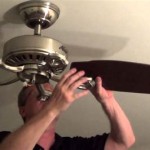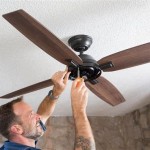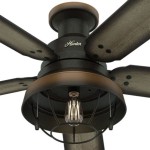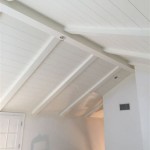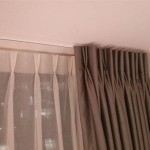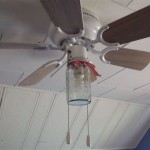What Is a False Ceiling Made Of?
A false ceiling, also known as a drop ceiling or suspended ceiling, is a secondary ceiling that is installed below the main structural ceiling of a building. They offer a range of benefits, including aesthetic appeal, improved acoustics, and better insulation. The material composition of a false ceiling is crucial in determining its functionality, durability, and overall impact on the interior space. This article delves into the various materials commonly used in false ceiling construction, providing a comprehensive understanding of their characteristics and applications.
Gypsum Board
Gypsum board, also known as drywall, is a popular material for false ceilings due to its affordability, ease of installation, and versatility. It is composed of a gypsum core sandwiched between two layers of paper, making it a lightweight and fire-resistant option. Gypsum board can be readily painted or textured to achieve a variety of finishes, and it is compatible with various lighting fixtures and ventilation systems. Its smooth surface also makes it easy to clean and maintain.
However, gypsum board has certain limitations. It is susceptible to moisture damage, making it unsuitable for humid environments. Additionally, it lacks the acoustic insulation properties of other materials, requiring additional soundproofing measures for rooms with high noise levels. Despite these drawbacks, gypsum board remains a widely used material for false ceilings, especially in residential and commercial spaces that prioritize cost-effectiveness and aesthetic flexibility.
Metal
Metal false ceilings, typically made of aluminum or steel, are known for their durability, fire resistance, and longevity. They offer a sleek and modern aesthetic, making them ideal for high-traffic areas and commercial buildings. These ceilings are often used in conjunction with other materials like gypsum board or mineral fiber tiles for added insulation and acoustic properties. Metal ceilings are also highly resistant to moisture and mold, making them suitable for bathrooms, kitchens, and outdoor applications.
One of the primary benefits of metal ceilings is their easy maintenance. They can be easily cleaned and sanitized, making them suitable for healthcare facilities and industrial environments. Additionally, metal ceilings offer excellent sound absorption properties, helping to create a more peaceful and comfortable atmosphere. However, metal ceilings can be more expensive than gypsum board, and their installation may require specialized tools and expertise.
Wood
Wood false ceilings offer a warm and natural aesthetic, adding a touch of sophistication to any space. They are typically made from plywood, wood planks, or timber, and can be finished with various stains, paints, or varnishes to achieve a desired look. Wood ceilings are known for their excellent sound absorption qualities, making them ideal for home theaters, recording studios, and other spaces where noise control is paramount. They also provide good thermal insulation, helping to regulate room temperature.
However, wood ceilings require more maintenance than other types of false ceilings. They are susceptible to moisture damage, warping, and insect infestation, which can necessitate periodic repairs or replacements. Also, wood ceilings can be more expensive than gypsum board ceilings, and their installation may require specialized carpentry skills. Nevertheless, wood ceilings remain a popular choice for homeowners who prioritize natural aesthetics and acoustic performance.
Mineral Fiber
Mineral fiber tiles are lightweight and easy to install, making them a popular choice for DIY projects and commercial applications. These tiles are made from minerals like glass, rock, and slag, and are often treated with a fire-retardant coating. Mineral fiber ceilings are known for their excellent sound absorption and thermal insulation properties, contributing to a quieter and more energy-efficient environment.
Mineral fiber tiles are also available in a variety of colors and textures, offering flexibility in design and customization. They are generally more resistant to moisture than gypsum board, making them suitable for bathrooms and other humid areas. However, mineral fiber tiles are prone to dust and dirt accumulation, requiring regular cleaning and maintenance. They also lack the durability and longevity of other materials like metal or wood.
PVC
PVC (polyvinyl chloride) false ceilings are gaining popularity due to their affordability, water resistance, and ease of maintenance. PVC panels are lightweight and easy to install, making them a suitable choice for DIY projects and renovation work. They are also available in various colors and designs, offering flexibility in creating unique and stylish interior spaces.
PVC ceilings are highly resistant to moisture and mold, making them perfect for bathrooms, kitchens, and outdoor spaces. They are also fire-retardant and easy to clean, contributing to a hygienic and comfortable environment. However, PVC ceilings lack the acoustic properties of other materials, and their aesthetic appeal may not be as desirable as wood or metal ceilings. Additionally, PVC is a synthetic material, making it less environmentally friendly than natural options like wood or mineral fiber.
False ceilings are a versatile and functional element in modern construction. By choosing the right material based on factors like budget, aesthetics, and performance requirements, homeowners and builders can create a space that is both beautiful and functional.

8 Types Of False Ceilings Commonly Used For Home Ultratech Cement

Technique To False Ceiling Installation Contractorbhai

False Ceiling Definition Benefits And Various Types Happho

8 Types Of False Ceilings Commonly Used For Home Ultratech Cement

Types Of False Ceiling Vm Singapore Partition Wall Contractor

What Are Modular Ceilings Made Of Sai Seva Service

8 Types Of False Ceilings Commonly Used For Home Ultratech Cement

Types Of False Ceiling Gypsum Glass Wooden Fiber Materials Nerolac
8 Types Of False Ceiling For Home

8 Types Of False Ceilings Commonly Used For Home Ultratech Cement
Related Posts

